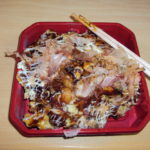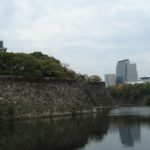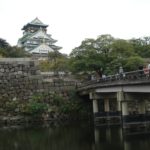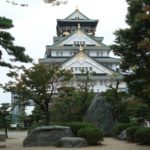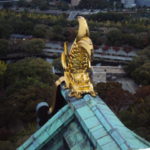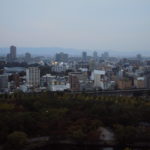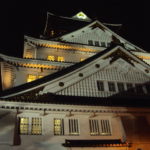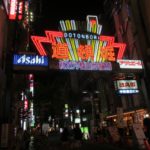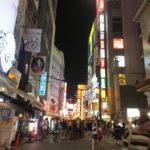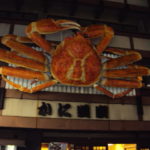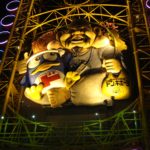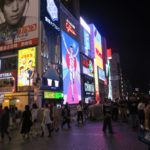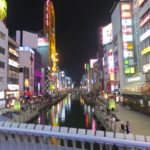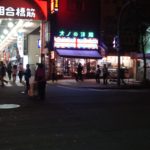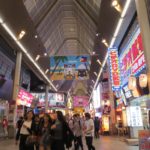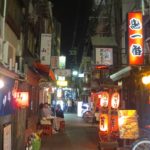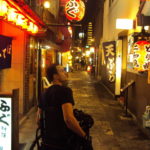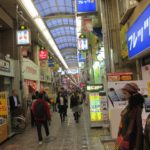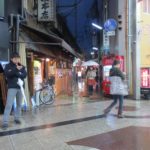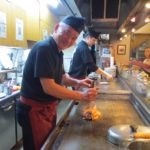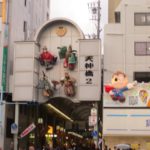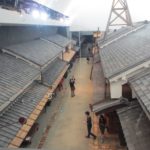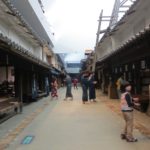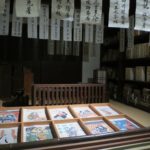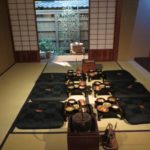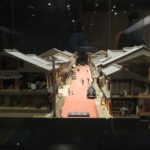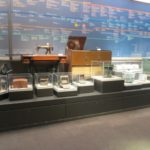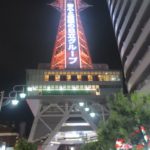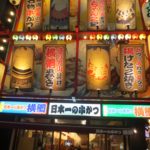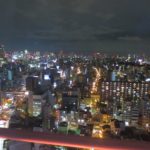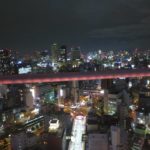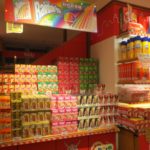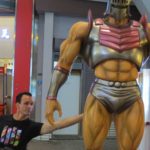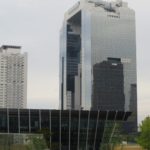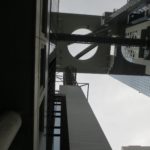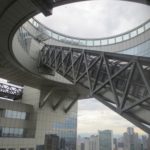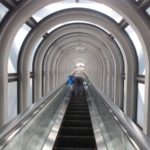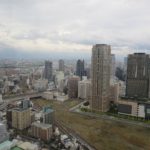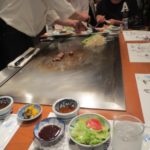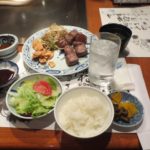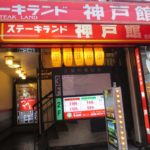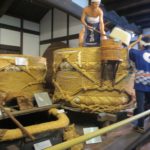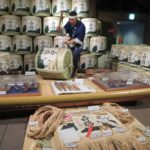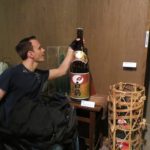A smaller and some might say more laid back version of Tokyo, Osaka is the largest city in the Kansai region – an area known for its culture, unique sense of humour, dialect, and food (like kushikatsu and its own variation of okonomiyaki).
Suggested duration of stay: If you’re going to visit attractions like the aquarium or Universal Studios, you may need to tack on an extra day, but otherwise, 3 days should suffice. It’s also possible to split time in Kyoto and come to Osaka at night (30 min train ride each way), since there’s more to do in the evenings here. Temples, shrines, castles & museums are typically 9-5, so you could plan accordingly, but I’d definitely suggest 5-7 days if you go that route (and use 1 city as your ‘home base’).
- Okonomiyaki – Osaka style!
- Enjoying some okonomiyaki in Dotonbori
Getting around:
Osaka International Airport (KIX) is the most direct route for visiting from outside of the country, but if you’re already on Japan’s main island, you’re more likely to arrive by ‘shinkansen’ (bullet train, which is approx. 2.5 hrs from Tokyo) or regional train (~30 mins from Kyoto or Kobe).
Once you’re in Osaka, subways and JR trains will be your best means of getting around. Just beware that if you do have a JR pass, there aren’t as many lines in Osaka as there are in Tokyo. There’s a main loop that covers most central Osaka, but you may need to consult a map to find out which stop gets you closest to your destination. In some cases, you may have to spring for a subsequent subway ride, if you’re not up for covering the distance yourself.
What I saw:
Osaka Castle – The iconic castle stands roughly 6 stories high and has an outdoor observation that provides a nice view of the grounds and surrounding area. The main tower is a reconstruction of the original, so the interior is basically a museum, with model representations and an illustrative history of the castle, its inhabitants, and the region.
- The moat, wall, and city in the distance
- Golden dragon fish statue
- City view
Dotonbori – One of Osaka’s biggest night time attractions, this extremely popular canal-side food and entertainment district comes alive at night, and lights up the sky!
- The sign says it all
- Mechanical crab sign
- Don Quixote – where you can find almost anything
- The infamous Glico Running Man
- Canal view
Shinsaibashi & Ebisubashi – Osaka’s famous shopping area for over 300 years, these covered shopping arcades neighbour Dotonbori and are always busy, with a wide variety of shops (e.g. traditional clothing, modern wear, jewelry, etc.) and places to eat – under the covered arcade and on the connecting side streets.
- entrance to Shinsaibashi
- Shisaibashi Shopping Arcade
- small izakayas & restaurants just off Shinsaibashi
- checking out the menu
Tenjinbashi-sugi – Located in the city’s Tenma (Kita) district, this 2.5 km covered shopping street claims to be the longest in Japan and is popular with locals searching for deals! It’s much longer and less opulent than Shinsaibashi-suji, with numerous restaurants, pachinko parlours, and variety of (mostly affordable) shops. It was raining quite heavily, when I was there, so it was great for providing shelter, had a very affordable kaiten sushi restaurant (where every plate was under 200 Yen!), and it went all the way from the Museum of Housing and Living to pretty much where we were staying (3 subway stops away)!
- Tenjinbashi-sugi – just outside of the Museum of Housing and Living
- where the outdoor streets meet the covered promenade
- ducked in here for some sake, a quick bite, and some friendly service 🙂
- The roof ends here, but starts up again on the other side of the street
The Museum of Housing and Living – Occupying 3 floors of a rather nondescript office building, this museum doesn’t sound like it would be overly exciting, but when they told us to start on the top floor (and work our way down), I was pleasantly surprised to see that I was overlooking a life-sized Edo period village! You can roam through the streets, homes, and even pay extra to go all out and rent a period costume, if you’re really looking to play the part. They even go so far as to change the lighting, to emulate nightfall, and throw in a thunderstorm for good measure (without the rain, thankfully)! The final level has maps and models of Edo period Osaka, and also lives up to its name, by showcasing various household appliances from the past century.
- overlooking the village from the top floor
- street level – where you can rent period outfits
- print shop in the village
- Inside one of the residences
- model of Osaka during the Edo Period
- household tech over the years
Tsutenkaku Tower – Over 100m high and the centerpiece of the Shinsekai district, this entertainment area and versions of the tower have been around since the early 1900’s. Fun fact: The lights on top of the tower are colour-coded to provide you with tomorrow’s weather forecast!
- Tsutenkaku
- Shinsekai sumo-themed restaurant
- observation level view
- wall of Glico goodies (mostly Pocky and Pretz)
- Dude’s pretty solid!
Umeda Sky Building – North of Osaka Station, this 39 storey building features a “floating garden observatory”, on its top floor. Unfortunately, the only way to access it is via a narrow escalator, so wheelchairs and other large mobility devices won’t be able to make it. Take a pass, if you aren’t ambulatory (or don’t feel like living vicariously through your travel companion’s pics or vids ;).
- Umeda Sky Building
- Looking up at the garden rooftop observation level from the ground
- escalator and partial city view
- escalator up to the garden rooftop observation level (too narrow for my ‘chair, unfortunately)
- Osaka – north view
Kobe – Apologies to anybody who’s lived or spent a great deal of time in this city, but my visits to Kobe were limited to trying their world-renowned beef (FYI – it’s roughly 1/3 the price, if you go for lunch instead of dinner) and checking out the Hakutsuru sake brewery museum. The train ride from Kyoto is about 50 mins (to JR Sannomiya Station) and just over 20 mins from Osaka Station, if you take the special rapid express trains. There are several restaurants near the aforementioned station that offer the melt-in-your-mouth Kobe beef, but of the two places I tried, Steak Land Kobe(kan) was better (there are 2 Steak Land locations in close proximity – I went to the one that’s a bit further from the station, on the 6th floor). For approximately 3000 Yen (~$30), you can have a set meal with soup, salad, rice, and the beef prepared teppanyaki style (i.e. cut into cubes with garlic chips added and cooked in front of you). If you’re a steak lover, or just a curious foodie, it’s well worth taking this side trip and splurging!
- Preparing the Kobe beef at Steak Land Kobe
- Kobe beef lunch set @ Steak Land Kobe
- This was the Steak Land location that I went to (there are 2 in close proximity)
- Illustrating how sake was originally made
- Making of the sake barrels
- Now THAT’S a bottle of sake!!
Where I stayed:
Sheraton Miyako Hotel Osaka (2009) – Let me preface what I’m about to say with 1) It was awhile ago and I’m sure the property has made some changes/renovations, with respect to in-room accessibility* and 2) I had enough points for a free stay (so that’s why I ended up staying here). It was a very nice hotel, located at the top of a steady incline from JR Tsuruhashi Station (heading TO the station was all down hill though, so that was nice! ;). The room itself was good, but it wasn’t an accessible one, so the bathroom doorway was too narrow for me to get in, unaided. Thankfully, I wasn’t travelling alone and we were able to make do by using the old “one wheel off” trick (to make the chair narrow enough to fit through the doorway, and then put it back on again inside the bathroom). The moral here is always contact the property directly, to ensure that the accommodations are suitable ahead of time! 🙂
Rating: n/a*
Toyoko Inn Osaka Umeda Higashi (2013) – A no frills business hotel, with a buffet breakfast included, this location was cost-friendly and had a very spacious “Heartful Room” (accessible room) right off of the lobby, on the main floor. But when the breakfast buffet was set up, it was pretty much RIGHT outside the door (at least I didn’t have to go far to get some food ;)! That made things a little loud and awkward, when I exited the room, but the bed was on the far side of the room (about 15 feet from the door, so that minimized the noise somewhat) and the bathroom layout was really good too.
Rating: 3.75/5
